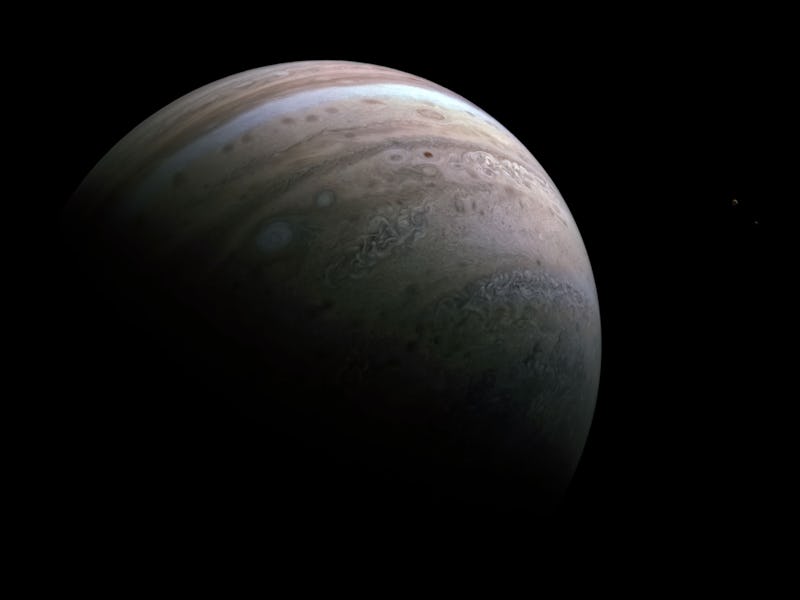Look: Jaw-dropping Jupiter NASA image reveals two cosmic Easter eggs
Io and Europa photobomb!

A beautiful new shot of Jupiter reveals two interlopers faintly creeping into the frame. The image, taken during a January 12 flyby of the giant planet by NASA’s intrepid Juno probe features a cameo of two of the most fascinating moons in the Solar System.
What the image shows — The picture released by NASA and the Juno team this week shows Jupiter’s chaotic South Pole and other regions of its southern hemisphere, partially enshrouded in darkness.
The images were taken during Juno’s January 12 pass around the planet — and while the view of Jupiter is impressive enough, if you squint and zoom in, you can spy two interlopers.
Jupiter looking all swirly and such, with some moons very faintly appearing.
Don’t quite see them? It’s not your fault.
The moons, Io and Europa, are only around 2 percent the radius of Jupiter. The Juno probe was, at the time, 38,000 miles away from Jupiter — though Juno’s closest orbit brings it 2,600 miles above Jupiter. At that point in its eccentric orbit, the probe is close enough to be battered by Jupiter’s intense radiation before it swings back far out.
So rather than squint to try and find Io and Europa like a cosmic Where’s Waldo?, here’s a little helpful arrow:
Hopefully this is helpful.
Zoomed in, the moons are still quite faint, a consequence of distance, deep space, darkness, and size. From this vantage point, it’s hard to tell that these are two of the most dynamic bodies in the outer Solar System — a place with no shortage of dynamic worlds.
Io and Europa are the two smallest Galilean moons. These moons are named after their discoverer, Galileo Galilei, who documented them for the first time in 1610 C.E.
The discovery of these four worlds cracked the prevailing view at the time as the universe literally revolving around Earth, with the Sun and the planets orbiting the Earth. Finding four large objects orbiting Jupiter made Galileo realize that Jupiter had its own little system — a heretical idea for the time. Galileo would eventually champion heliocentrism, the idea that the planets orbit the Sun, a view that led to him being branded a heretic and kept under house arrest until the end of his life.
There they are.
Europa and Io revealed
What Galileo couldn’t have known at the time — and indeed, what astronomers didn’t fully understand until the Pioneer 10 and 11 and Voyager 1 and 2 probes visited Jupiter in the 1970s — is that these worlds are active and, in the case of Europa, potentially even life-bearing.
As the two smallest Galilean moons, they’re the size of our own Moon, while their massive siblings Ganymede and Callisto are roughly the same sizes as Mercury.
The contrast between Io and Europa is stark, like heaven and hell.
Io, the innermost large moon of Jupiter, is stretched and squeezed by Jupiter’s intense gravity, resulting in a molten interior that spews forth in sulfurous magma hundreds of miles into space. It’s hard to imagine a more inhospitable moon in the Solar System.
Europa however is perhaps one of the most exciting places in the Solar System. This world is largely composed of water. Beneath an ice shell polluted with irradiated salts lies a vast global ocean, one so huge it dwarfs all the water on Earth. This ocean is believed to be one of the best places to find life beyond Earth and is the subject of an upcoming NASA mission called the Europa Clipper.
Don’t expect to ever go there to find aliens yourself, though. The surface of Europa is battered in Jupiter’s hellish radiation enough that you’d be fried alive. But any life there is protected by the 11 to 15-mile deep ice shell. At times, water from this deep interior creeps to the surface in the form of geysers.
When the Clipper launches in 2024, we’ll be one step closer to unprecedented images of the stunning world. But for now, we’ll have to settle for little glimpses from Juno, which thankfully gets some great opportunities.
Editor’s note: This article was updated on March 22, 2022 to correct the spelling of Galileo Galilei’s name.